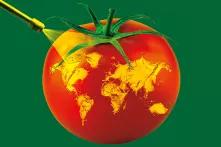
The European Union is one of the world’s biggest markets for pesticides. Policies to reduce their use have not been very successful so far. The lack of standardized data makes monitoring and comparing countries difficult.

In the past decade, sales of pesticides in the EU have remained more or less stable at around 360,000 tonnes per year. However, the sales volume of pesticides alone tells us little about the risks to humans, animals, and the environment. Other factors such as the toxicity of the substances, methods of application, application rates, or the frequency of application also play a role. And: Detailed statistics on the use of pesticides per crop and per country are currently unavailable in the EU. Due to the lack of systematic collection of such data at national and European levels, sale volumes serve as proxy.
Almost a quarter of all pesticides are sold in the European Union. The market was valued at 12 billion euros in 2019, compared to 53 billion euros worldwide. It is also the top exporting region, with 5.8 billion euros in exports to third countries that same year. More than 450 pesticide active ingredients are currently approved in the European Union. This figure has remained stable over the last decade. Authorities have removed some substances from the market because of their toxicity, but have continued to approve new ones. Some pesticides that are banned in the EU can still find their way onto European crops. One reason for this can be found in the use of illegal and counterfeit pesticides, which represent up to 14 percent of the EU market. Provisions for temporary exceptions are another reason why pesticides are still used on European crops. In case of a so-called ‘emergency’, Member States can allow their farmers the usage of a specific substance for a period of 120 days. Over the last six years, 3,600 such exceptions have been granted for the use of non-authorized pesticides in Member States. In addition, the authorisation of some active ingredients keeps getting extended despite their critical toxicity for human and environmental health.
According to Eurostat, France, Italy, Spain and Germany were the biggest markets for pesticides within the EU. Significant differences in sales’ evolution exist between EU Member States. For example, in 2019 the volume of pesticides sold in Denmark was 42 percent lower than in 2011, but significantly higher in Cyprus and Latvia. However, the volumes of pesticides sold in these latter countries in absolute terms are relatively low.
When looking at the pesticide application per area of land instead of overall sales, regional differences can be significant: In Romania for example, many pesticides are applied in intensively farmed areas whereas use is negligible in the Carpathians in the North. An important reason for differences in pesticide use between Member States is the type of production that characterizes the country’s agricultural model. Countries such as Italy with large areas of permanent cropland for fruit and ornamental plants use more pesticides than countries where pasture makes up more than 80 percent of agricultural land. Farmers may treat the same area of permanent cropland more than 30 times a year with fungicides. Varying degrees of policies pushing for the uptake of non-chemical alternatives to pesticides are another factor.
For example, Luxembourg is the only European country that banned the use of all products containing the herbicide glyphosate from 1 January 2021. The country also uses funding from the EU’s Common Agricultural Policy to phased out all uses of insecticides in their vines and replace them with non-chemical alternatives. On the other hand, some Member States, such as France or Belgium, provide derogations, on a yearly basis, for the use of pesticides that were banned in the EU because of their toxicity.
The most significant decrease in pesticide use has been observed in Denmark. The Scandinavian country first implemented a pesticide fee in 1972 and supplemented this with a pesticide tax in 1982. Since July 2013, the tax is not linked to the nominal value, but the toxicity of the substance on human health, environment, and groundwater. All of the revenue generated by the tax is reimbursed to the agricultural sector, which eased resistance among farmers’ organizations. The experiences made in Denmark indicate that a risk-based levy can bring down the total sales of plant protection products as well as the sales of particularly hazardous pesticides. The EU could also introduce its own specific taxation concept. Other policy measures that could reduce pesticide use include trainings for farmers, investments in more research for agroecology or more conditions around integrated pest management for funds of the Common Agricultural Policy.
In 2020, the European Commission presented its Farm to Fork and Biodiversity strategies. Among the objectives of these plans are to reduce by 50 percent the use and risk of chemical pesticides by 2030 and to reduce by 50 percent the use of more hazardous pesticides by 2030. The diversity of pesticide use in the EU appears to be a point of contention for Member States to agree on the respective national reduction efforts. Changes within this new legislative framework could also make it possible to better monitor how much, how often, where and which pesticides are used in food production in Europe – data we do not have up to this day.

